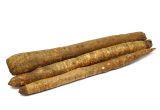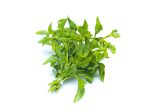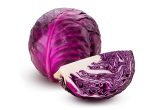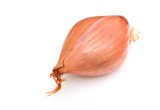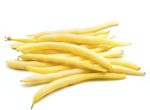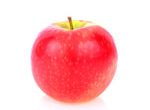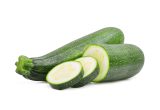Button mushroom

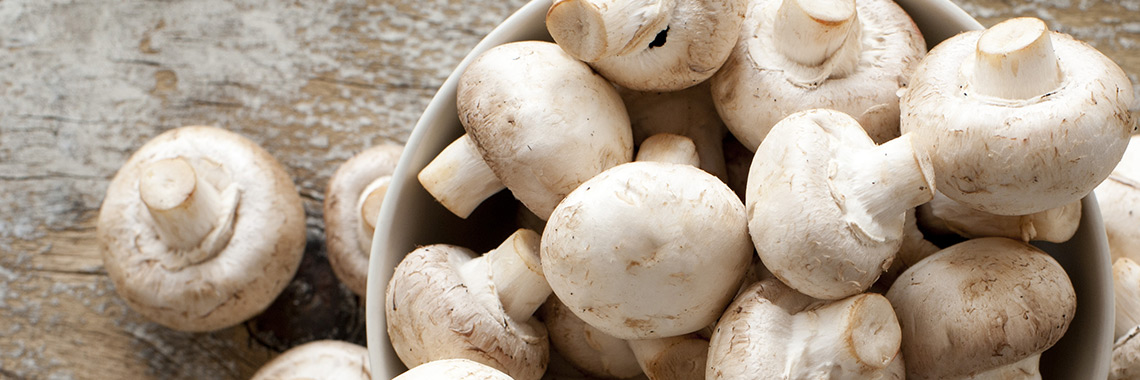
Description
- The button mushroom (Agaricus bisporus) belongs to the Agaricaceae family.
- There are many varieties of mushrooms. However, the button mushroom is one of the most consumed in the world (He, 2014).
PHYSICAL AND ORGANOLEPTIC CHARACTERISTICS
- The colour of the button mushroom depends on a single gene, leading to two colour possibilities: white or brown (Gao, 2013).
- Certain factors can cause browning of the mushroom during the post-harvest period. These include the presence of the enzyme polyphenol oxidase and phenolic compounds, but also the number of rinses and the post-harvest environment. Many techniques, such as chilling and modified atmosphere packaging (MAP), have been developed to control the browning of button mushrooms (Lin, 2019).
- Mushrooms have a high percentage of easily digestible protein and have a texture similar to meat (Patinho, 2019).
COMPOSITION CHARACTERISTICS (excluding macronutrients, vitamins and minerals)
- The main phenolic compounds identified in A. bisporus mushroom extract are myricetin (2729.46 μg/g), followed by caffeic acid (392.51 μg/g) and gallic acid (280.45 μg/g) (Gasecka, 2018).
- Fungi are known for their anti-tumour activities. Several works have highlighted the potential inhibitory effects of polysaccharides, particularly (1 → 3)-β-D-glucans, on tumours due to their chemical composition, configuration, and physical properties (Meng, 2016).
- Mushrooms contain carbohydrates, such as chitin, hemicellulose, β- and α-glucans, mannans, xylans and galactans, which may explain their beneficial effects on gut microbiota (Jayachandran, 2017).
RAW
The following values are approximate and depend on variety, season, ripeness, cultivation conditions, etc.
Raw mushrooms are low in energy* as they provide an average of 28 calories (kcal) per 100 g, i.e. 118 kJ. A portion of raw mushrooms weighs on average 80 g, which corresponds to an energy intake of approximately 17.28 kcal.
COMPOSITION TABLES
For each nutrient, the tables provide information on the content, minimum and maximum values and the percentage of the Dietary Reference Values (DRVs) per 100 g net of raw button mushrooms.
MACRONUTRIENTS
| Constituent (g) | Average content |
Min-Max per 100g |
DRV% |
|---|---|---|---|
| Water | 93,9 | 87,50 - 95,50 | - |
| Fibers | 1 | NC - 1,90 | - |
| Carbohydrates | 3,15 | 0 - NC | 1,21 |
| Sugars | 2,50 | - | 2,78 |
| Lipids | 0,36 | 0,20 - 0,49 | 0,51 |
| Saturated fat | 0,067 | 0,026 - 0,075 | 0,34 |
| Protein | 2,62 | 0,30 - 4,38 | 5,24 |
| Constituent (g) | Amount | Min-Max | DRV% |
|---|---|---|---|
| Water | Ciqual 2020 Visible | - | - |
| Fibers | Ciqual 2020 | - | - |
| Carbohydrates | Ciqual 2020 | - | Règlement (UE) N°1169/2011 du parlement Européen et du conseil du 25 octobre 2011 % |
| Sugars | Ciqual 2020 | - | Règlement (UE) N°1169/2011 du parlement Européen et du conseil du 25 octobre 2011 |
| Lipids | Ciqual 2020 | - | Règlement (UE) N°1169/2011 du parlement Européen et du conseil du 25 octobre 2011 |
| Saturated fat | Ciqual 2020 | - | Règlement (UE) N°1169/2011 du parlement Européen et du conseil du 25 octobre 2011 |
| Protein | Ciqual 2020 | - | Règlement (UE) N°1169/2011 du parlement Européen et du conseil du 25 octobre 2011 |
Zoom on carbohydrates
- The amount of carbohydrates in raw mushrooms (3.15 g per 100 g) is well below the average amount in raw vegetables (4.45 g per 100 g).
Zoom on fibres
- The fibre content (1 g per 100 g) of raw mushrooms is lower than the average amount found in raw vegetables (2.43 g per 100 g).
Zoom on proteins
- The amount of protein (2.62 g per 100 g) in raw mushrooms is higher than the average amount found in raw vegetables (1.87 g per 100 g).
- Raw mushrooms are low in sugar* as they contain less than 5 g per 100 g.
Zoom on lipids
- The fat content (0.36 g per 100 g) of raw mushrooms is lower than the average amount found in raw vegetables (0.56 g per 100 g).
- Raw mushrooms are fat-free* as they contain less than 0.5 g per 100 g.
Regulation (EC) No 1924/2006 of the European Parliament and of the Council of 20 December 2006 on nutrition and health claims made on foods.
MINERALS AND TRACE ELEMENTS
| Constituent | Average content |
Min-Max per 100g |
DRV% |
|---|---|---|---|
| Calcium (mg) | 6,03 | 1 - 35,50 | 0,75 |
| Chloride (mg) | - | - | - |
| Copper (mg) | 0,35 | 0,13 - 1,10 | 35 |
| Iron (mg) | 0,31 | 0,19 - 0,60 | 2,21 |
| Iodine (µg) | 1 | - | 0,67 |
| Magnesium (mg) | 10,50 | 7,90 - 13,50 | 2,80 |
| Manganese (mg) | 0,076 | 0,042 - 0,14 | 3,80 |
| Phosphorus (mg) | 96,6 | 67,20 - 130 | 13,80 |
| Potassium (mg) | 364 | 284 - 484 | 18,20 |
| Selenium (µg) | 6,47 | NC - 17,90 | 11,76 |
| Sodium (mg) | 39 | 4,90 - NC | - |
| Zinc (mg) | 0,50 | 0,12 - 0,79 | 5 |
| Constituent | Amount | Min-Max | DRV% |
|---|---|---|---|
| Calcium (mg) | Ciqual 2020 | - | Règlement (UE) N°1169/2011 du parlement Européen et du conseil du 25 octobre 2011 |
| Chloride (mg) | Ciqual 2020 | - | Règlement (UE) N°1169/2011 du parlement Européen et du conseil du 25 octobre 2011 |
| Copper (mg) | Ciqual 2020 | - | Règlement (UE) N°1169/2011 du parlement Européen et du conseil du 25 octobre 2011 |
| Iron (mg) | Ciqual 2020 | - | Règlement (UE) N°1169/2011 du parlement Européen, et du conseil du 25 octobre 2011 |
| Iodine (µg) | Ciqual 2020 | - | Règlement (UE) N°1169/2011 du parlement Européen et du conseil du 25 octobre 2011 |
| Magnesium (mg) | Ciqual 2020 | - | Règlement (UE) N°1169/2011 du parlement Européen et du conseil du 25 octobre 2011 |
| Manganese (mg) | Ciqual 2020 | - | Règlement (UE) N°1169/2011 du parlement Européen et du conseil du 25 octobre 2011 |
| Phosphorus (mg) | Ciqual 2020 | - | Règlement (UE) N°1169/2011 du parlement Européen et du conseil du 25 octobre 2011 |
| Potassium (mg) | Ciqual 2020 | - | Règlement (UE) N°1169/2011 du parlement Européen et du conseil du 25 octobre 2011 |
| Selenium (µg) | Ciqual 2020 | - | Règlement (UE) N°1169/2011 du parlement Européen et du conseil du 25 octobre 2011 |
| Sodium (mg) | Ciqual 2020 | - | - |
| Zinc (mg) | Ciqual 2020 | - | Règlement (UE) N°1169/2011 du parlement Européen et du conseil du 25 octobre 2011 |
Zoom on minerals and trace elements
- Raw mushrooms are high in copper, as they provide the equivalent of 35% of DRVs, i.e. 0.35 mg per 100 g. Moreover, according to the Ciqual 2020 table, mushrooms are the vegetable with the highest copper content.
- They are also a source of potassium, as they provide the equivalent of 18.20% of DRVs, i.e. 364 mg per 100 g.
- They also contain a significant amount of phosphorus and selenium as they represent:
- 13.80% of DRVs for phosphorus, i.e. 96.60 mg per 100 g;
- 11.76% of DRVs for selenium, i.e. 6.47 mg per 100 g.
- The other minerals and trace elements are present in quantities representing less than 8% of DRVs.
VITAMINS
| Constituent | Average content |
Min-Max per 100g |
DRV% |
|---|---|---|---|
| Provitamin A Beta-carotene (µg) | - | - | - |
| Vitamin A equivalent (µg) | - | - | - |
| Vitamin B1 (mg) | 0,084 | 0,009 - 0,12 | 7,64 |
| Vitamin B2 (mg) | 0,42 | 0,22 - 0,61 | 30 |
| Vitamin B3 (mg) | 4,55 | 0,22 - 7,5 | 28,44 |
| Vitamin B5 (mg) | 1,75 | 1,06 - 2,28 | 29,17 |
| Vitamin B6 (mg) | 0,082 | 0,041 - 0,23 | 5,86 |
| Vitamin B9 (µg) | 29 | 10 - 55 | 14,50 |
| Vitamin C (mg) | 3,09 | - | 3,86 |
| Vitamin E (mg) | 0,02 | 0 - NC | 0,17 |
| Vitamin K1 (µg) | - | NC - 0,1 | - |
| Constituent | Amount | Min-Max | DRV% |
|---|---|---|---|
| Provitamin A Beta-carotene (µg) | Ciqual 2020 | - | - |
| Vitamin A equivalent (µg) | Ciqual 2020 | - | - |
| Vitamin B1 (mg) | Ciqual 2020 | - | Règlement (UE) N°1169/2011 du parlement Européen et du conseil du 25 octobre 2011 |
| Vitamin B2 (mg) | Ciqual 2020 | - | Règlement (UE) N°1169/2011 du parlement Européen et du conseil du 25 octobre 2011 |
| Vitamin B3 (mg) | Ciqual 2020 | - | Règlement (UE) N°1169/2011 du parlement Européen et du conseil du 25 octobre 2011 |
| Vitamin B5 (mg) | Ciqual 2020 | - | Règlement (UE) N°1169/2011 du parlement Européen et du conseil du 25 octobre 2011 |
| Vitamin B6 (mg) | Ciqual 2020 | - | Règlement (UE) N°1169/2011 du parlement Européen et du conseil du 25 octobre 2011 |
| Vitamin B9 (µg) | Ciqual 2020 | - | Règlement (UE) N°1169/2011 du parlement Européen et du conseil du 25 octobre 2011 |
| Vitamin C (mg) | Ciqual 2020 | - | Règlement (UE) N°1169/2011 du parlement Européen et du conseil du 25 octobre 2011 |
| Vitamin E (mg) | Ciqual 2020 | - | Règlement (UE) N°1169/2011 du parlement Européen et du conseil du 25 octobre 2011 |
| Vitamin K1 (µg) | Ciqual 2020 | - | Règlement (UE) N°1169/2011 du parlement Européen et du conseil du 25 octobre 2011 |
Zoom on vitamins
- Raw mushrooms are high in vitamin B3, as they represent 31.25% of DRVs, i.e. 5 mg per 100 g.
- Raw mushrooms are also a source of:
- vitamin B5, as they represent 26.17% of DRVs, i.e. 1.57 mg per 100 g;
- vitamin B2, as they represent 20.71% of DRVs, i.e. 0.29 mg per 100 g;
- vitamin B9, as they represent 17.25% of DRVs, i.e. 34.50 µg per 100 g.
- According to the Ciqual 2020 table, the mushroom is the vegetable that contains the most vitamin B2, vitamin B3 and vitamin B5.
- The other vitamins represent less than 8% of DRVs.
Calculation made: Beta-Carotene / 6 + retinol
POLYPHENOLS
SAUTÉED
The following values are approximate and depend on variety, season, ripeness, cultivation conditions, etc.
Cooked (sautéed, without fat) button mushrooms are low in energy* as they provide an average of 38.40 calories (kcal) per 100 g, i.e. 161 kJ. A portion of cooked mushrooms weighs on average 80 g, which corresponds to an energy intake of approximately 30.72 kcal.
COMPOSITION TABLES
For each nutrient, the tables provide information on the content, minimum and maximum values and the percentage of the Dietary Reference Values (DRVs) for 100 g net of sautéed/fried mushrooms without fat.
MACRONUTRIENTS
| Constituent (g) | Average content |
Min-Max per 100g |
DRV% |
|---|---|---|---|
| Water | 88,4 | NC - 91,10 | - |
| Fibers | 0,90 | NC - 1,80 | - |
| Carbohydrates | 4,53 | - | 1,74 |
| Sugars | - | - | - |
| Lipids | 0,60 | 0,33 - NC | 0,86 |
| Saturated fat | 0,18 | - | 0,90 |
| Protein | 4,40 | 3,58 - NC | 8,80 |
| Constituent (g) | Amount | Min-Max | DRV% |
|---|---|---|---|
| Water | Ciqual 2020 (valeur issue des analyses Ciqual-Aprifel 2018) | - | - |
| Fibers | Ciqual 2020 (valeur issue des analyses Ciqual-Aprifel 2018) | - | - |
| Carbohydrates | Ciqual 2020 | - | Règlement (UE) N°1169/2011 du parlement Européen et du conseil du 25 octobre 2011 |
| Sugars | Ciqual 2020 (valeur issue des analyses Ciqual-Aprifel 2018) | - | Règlement (UE) N°1169/2011 du parlement Européen, et du conseil du 25 octobre 2011 |
| Lipids | Ciqual 2020 (valeur issue des analyses Ciqual-Aprifel 2018) | - | Règlement (UE) N°1169/2011 du parlement Européen et du conseil du 25 octobre 2011 |
| Saturated fat | Ciqual 2020 (valeur issue des analyses Ciqual-Aprifel 2018) | - | Règlement (UE) N°1169/2011 du parlement Européen et du conseil du 25 octobre 2011 |
| Protein | Ciqual 2020 | - | Règlement (UE) N°1169/2011 du parlement Européen et du conseil du 25 octobre 2011 |
Zoom on carbohydrates
- The amount of carbohydrate in sautéed mushrooms (4.53 g per 100 g) is slightly lower than the average amount in cooked vegetables (4.85 g per 100 g).
- The carbohydrates are mainly polyols in the form of mannitol (3 g per 100 g).
- Sautéed mushrooms are sugar-free* as they contain less than 0.5 g per 100 g.
Zoom on fibres
- The fibre content (0.90 g per 100 g) of sautéed mushrooms is lower than the average amount found in cooked vegetables (2.89 g per 100 g).
Zoom on proteins
- The amount of protein (4.40 g per 100 g) in sautéed mushrooms is much higher than the average amount found in cooked vegetables (2 g per 100 g).
Zoom on lipids
- The fat content (0.60 g per 100 g) of sautéed mushrooms is slightly higher than the average amount found in cooked vegetables (0.53 g per 100 g).
- Sautéed mushrooms are low in fat* as they contain less than 3 g per 100 g.
Regulation (EC) No 1924/2006 of the European Parliament and of the Council of 20 December 2006 on nutrition and health claims made on foods.
MINERALS AND TRACE ELEMENTS
| Constituent | Average content |
Min-Max per 100g |
DRV% |
|---|---|---|---|
| Calcium (mg) | 2,70 | NC - 4 | 0,34 |
| Chloride (mg) | 132 | - | 16,50 |
| Copper (mg) | 0,39 | 0,29 - NC | 39 |
| Iron (mg) | 0,31 | 0,25 - NC | 2,21 |
| Iodine (µg) | < 20 | - | - |
| Magnesium (mg) | 14 | 11 - NC | 3,73 |
| Manganese (mg) | 0,05 | 0,047 - NC | 2,50 |
| Phosphorus (mg) | 140 | 105 - NC | 20 |
| Potassium (mg) | 540 | 396 - NC | 27 |
| Selenium (µg) | < 20 | - | - |
| Sodium (mg) | 11 | NC - 12 | - |
| Zinc (mg) | 0,81 | 0,57 - NC | 8,10 |
| Constituent | Amount | Min-Max | DRV% |
|---|---|---|---|
| Calcium (mg) | Ciqual 2020 (valeur issue des analyses Ciqual-Aprifel 2018) | - | Règlement (UE) N°1169/2011 du parlement Européen et du conseil du 25 octobre 2011 |
| Chloride (mg) | Ciqual 2020 (valeur issue des analyses Ciqual-Aprifel 2018) | - | Règlement (UE) N°1169/2011 du parlement Européen et du conseil du 25 octobre 2011 |
| Copper (mg) | Ciqual 2020 (valeur issue des analyses Ciqual-Aprifel 2018) | - | Règlement (UE) N°1169/2011 du parlement Européen et du conseil du 25 octobre 2011 |
| Iron (mg) | Ciqual 2020 (valeur issue des analyses Ciqual-Aprifel 2018) | - | Règlement (UE) N°1169/2011 du parlement Européen et du conseil du 25 octobre 2011 |
| Iodine (µg) | Ciqual 2020 (valeur issue des analyses Ciqual-Aprifel 2018) | - | Règlement (UE) N°1169/2011 du parlement Européen et du conseil du 25 octobre 2011 |
| Magnesium (mg) | Ciqual 2020 (valeur issue des analyses Ciqual-Aprifel 2018) | - | Règlement (UE) N°1169/2011 du parlement Européen et du conseil du 25 octobre 2011 |
| Manganese (mg) | Ciqual 2020 (valeur issue des analyses Ciqual-Aprifel 2018) | - | Règlement (UE) N°1169/2011 du parlement Européen et du conseil du 25 octobre 2011 |
| Phosphorus (mg) | Ciqual 2020 (valeur issue des analyses Ciqual-Aprifel 2018) | - | Règlement (UE) N°1169/2011 du parlement Européen et du conseil du 25 octobre 2011 |
| Potassium (mg) | Ciqual 2020 (valeur issue des analyses Ciqual-Aprifel 2018) | - | Règlement (UE) N°1169/2011 du parlement Européen et du conseil du 25 octobre 2011 |
| Selenium (µg) | Ciqual 2020 (valeur issue des analyses Ciqual-Aprifel 2018) | - | Règlement (UE) N°1169/2011 du parlement Européen et du conseil du 25 octobre 2011 |
| Sodium (mg) | Ciqual 2020 (valeur issue des analyses Ciqual-Aprifel 2018) | - | - |
| Zinc (mg) | Ciqual 2020 (valeur issue des analyses Ciqual-Aprifel 2018) | - | Règlement (UE) N°1169/2011 du parlement Européen et du conseil du 25 octobre 2011 |
Zoom on minerals and trace elements
- Sautéed mushrooms are high in copper, as they provide the equivalent of 39% of DRVs, i.e. 0.39 mg per 100 g. In fact, according to the Ciqual 2020 table, mushrooms are the vegetable with the highest copper content.
- They are also a source of:
- potassium, as they provide the equivalent of 27% of DRVs, i.e. 540 mg per 100 g; according to the data in the Ciqual 2020 table, sautéed mushrooms are, after baby spinach, the vegetable with the highest potassium content.
- phosphorus, as they provide the equivalent of 20% of DRVs, i.e. 140 mg per 100 g,
- chloride, as they provide the equivalent of 16.50% of DRVs, i.e. 132 mg per 100 g.
- The other minerals and trace elements are present in quantities representing less than 9% of DRVs.
VITAMINS
| Constituent | Average content |
Min-Max per 100g |
DRV% |
|---|---|---|---|
| Provitamin A Beta-carotene (µg) | < 5 | 0 - NC | - |
| Vitamin A equivalent (µg) | < 0,83 | 0 - NC | - |
| Vitamin B1 (mg) | 0,062 | NC - 0,096 | 5,64 |
| Vitamin B2 (mg) | 0,36 | NC - 0,46 | 25,71 |
| Vitamin B3 (mg) | 4,53 | 3,99 - NC | 28,31 |
| Vitamin B5 (mg) | 2,33 | 1,45 - NC | 38,83 |
| Vitamin B6 (mg) | 0,029 | NC - 0,042 | 2,07 |
| Vitamin B9 (µg) | 14,30 | NC - 20 | 7,15 |
| Vitamin C (mg) | < 0,50 | - | - |
| Vitamin E (mg) | < 0,08 | 0 - NC | - |
| Vitamin K1 (µg) | < 0,80 | 0 - NC | - |
| Constituent | Amount | Min-Max | DRV% |
|---|---|---|---|
| Provitamin A Beta-carotene (µg) | Ciqual 2020 (valeur issue des analyses Ciqual-Aprifel 2018) | - | - |
| Vitamin A equivalent (µg) | Calcul à partir de la valeur Provitamine A Béta-carotène* | - | Règlement (UE) N°1169/2011 du parlement Européen et du conseil du 25 octobre 2011 |
| Vitamin B1 (mg) | Ciqual 2020 (valeur issue des analyses Ciqual-Aprifel 2018) | - | Règlement (UE) N°1169/2011 du parlement Européen et du conseil du 25 octobre 2011 |
| Vitamin B2 (mg) | Ciqual 2020 (valeur issue des analyses Ciqual-Aprifel 2018) | - | Règlement (UE) N°1169/2011 du parlement Européen et du conseil du 25 octobre 2011 |
| Vitamin B3 (mg) | Ciqual 2020 (valeur issue des analyses Ciqual-Aprifel 2018) | - | Règlement (UE) N°1169/2011 du parlement Européen et du conseil du 25 octobre 2011 |
| Vitamin B5 (mg) | Ciqual 2020 (valeur issue des analyses Ciqual-Aprifel 2018) | - | Règlement (UE) N°1169/2011 du parlement Européen, et du conseil du 25 octobre 2011 |
| Vitamin B6 (mg) | Ciqual 2020 (valeur issue des analyses Ciqual-Aprifel 2018) | - | Règlement (UE) N°1169/2011 du parlement Européen et du conseil du 25 octobre 2011 |
| Vitamin B9 (µg) | Ciqual 2020 (valeur issue des analyses Ciqual-Aprifel 2018) | - | Règlement (UE) N°1169/2011 du parlement Européen et du conseil du 25 octobre 2011 |
| Vitamin C (mg) | Ciqual 2020 (valeur issue des analyses Ciqual-Aprifel 2018) | - | Règlement (UE) N°1169/2011 du parlement Européen et du conseil du 25 octobre 2011 |
| Vitamin E (mg) | Ciqual 2020 | - | Règlement (UE) N°1169/2011 du parlement Européen et du conseil du 25 octobre 2011 |
| Vitamin K1 (µg) | Ciqual 2020 (valeur issue des analyses Ciqual-Aprifel 2018) | - | Règlement (UE) N°1169/2011 du parlement Européen et du conseil du 25 octobre 2011 |
Zoom on vitamins
- Sautéed mushrooms are high in vitamin B5, as they represent 38.83% of DRVs, i.e. 2.33 mg per 100 g.
- Sautéed mushrooms are also a source of:
- vitamin B3, as they represent 28.31% of DRVs, i.e. 4.53 mg per 100 g;
- vitamin B2, as they represent 25.71% of DRVs, i.e. 0.36 mg per 100 g.
- Moreover, according to the data of the Ciqual 2020 table, the mushroom is the vegetable that contains the most vitamin B5, vitamin B3 and vitamin B2.
- The other vitamins are less present in cooked mushrooms because they represent less than 8% of DRVs.
Calculation made: Beta-Carotene / 6 + retinol
POLYPHENOLS
Nutrition and health claims
Regulation (EC) No 1924/2006 of the European Parliament and of the Council of 20 December 2006 on nutrition and health claims made on foods.
According to the definitions of nutrition claims as set out in Regulation (EC) No 1924/2006 on nutrition and health claims, and in view of the composition of the raw button mushroom, the following claims may be used:
NUTRITION CLAIMS OF RAW BUTTON MUSHROOMS
- Low in energy (100 g of raw mushrooms provide less than 40 kcal)
- Fat-free (100 g of raw mushrooms contain less than 0.5 g of fat)
- Low in sugar (100 g of raw mushrooms do not contain more than 5 g of sugar)
- High in copper (100 g of raw mushrooms provide more than 30% of DRVs)
- High in vitamin B3 (100 g of raw mushrooms provide more than 30% of DRVs)
- Source of vitamin B5 (100 g of raw mushrooms provide more than 15% of DRVs)
- Source of vitamin B2 (100 g of raw mushrooms provide more than 15% of DRVs)
- Source of potassium (100 g of raw mushrooms provide more than 15% of DRVs)
- Source of vitamin B9 (100 g of raw mushrooms provide more than 15% of DRVs)
HEALTH CLAIMS (for a consumption of 100 g of raw button mushrooms)
Copper
- Copper contributes to:
- maintenance of normal connective tissues,
- normal energy-yielding metabolism,
- normal functioning of the nervous system,
- normal hair pigmentation,
- normal iron transport in the body,
- normal skin pigmentation,
- normal function of the immune system,
- protection of cells from oxidative stress.
Vitamin B3 or niacin
- Vitamin B3 contributes to:
- normal psychological function,
- normal energy-yielding metabolism,
- normal functioning of the nervous system,
- maintenance of normal skin,
- maintenance of normal mucous membranes,
- reduction of tiredness and fatigue.
Vitamin B5 or pantothenic acid
- Pantothenic acid contributes to:
- normal energy-yielding metabolism,
- normal mental performance,
- normal synthesis and metabolism of steroid hormones, vitamin D and some neurotransmitters,
- reduction of tiredness and fatigue.
Vitamin B2 or riboflavin
- Riboflavin contributes to:
- normal energy-yielding metabolism,
- normal functioning of the nervous system,
- maintenance of normal mucous membranes,
- maintenance of normal red blood cells,
- maintenance of normal skin,
- maintenance of normal vision,
- normal iron metabolism,
- protection of cells from oxidative stress,
- reduction of tiredness and fatigue.
Potassium
- Potassium contributes to:
- normal functioning of the nervous system,
- normal muscle function,
- maintenance of normal blood pressure.
Folates or vitamin B9
- Folates contribute to:
- maternal tissue growth during pregnancy,
- normal amino acid synthesis,
- normal blood formation,
- normal homocysteine metabolism,
- normal psychological function,
- normal function of the immune system,
- reduction of tiredness and fatigue.
- Folates have a role in the process of cell division.
Nutrition and health claims
Regulation (EC) No 1924/2006 of the European Parliament and of the Council of 20 December 2006 on nutrition and health claims made on foods.
According to the definitions of nutrition claims as set out in Regulation (EC) No 1924/2006 on nutrition and health claims, and in view of the composition of sautéed mushrooms, the following claims may be used:
NUTRITION CLAIMS OF SAUTED BUTTON MUSHROOMS (without fat)
- Low in energy (100 g of sautéed mushrooms provide less than 40 kcal)
- Low in fat (100 g of sautéed mushrooms contain less than 3 g of fat)
- Sugar-free (100 g of sautéed mushrooms contain no more than 0.5 g of sugar)
- High in copper (100 g of sautéed mushrooms provide more than 30% of DRVs)
- High in vitamin B5 (100 g of sautéed mushrooms provide more than 30% of DRVs)
- Source of vitamin B3 (100 g of sautéed mushrooms provide more than 15% of DRVs)
- Source of potassium (100 g of sautéed mushrooms provide more than 15% of DRVs)
- Source of vitamin B2 (100 g of sautéed mushrooms provide more than 15% of DRVs)
- Source of phosphorus (100 g of sautéed mushrooms provide more than 15% of DRVs)
- Source of chloride (100 g of sautéed mushrooms provide more than 15% of DRVs)
HEALTH CLAIMS (for a consumption of 100 g of sautéed button mushrooms without fat)
Copper
- Copper contributes to:
- maintenance of normal connective tissues,
- normal energy-yielding metabolism,
- normal functioning of the nervous system,
- normal hair pigmentation,
- normal iron transport in the body,
- normal skin pigmentation,
- normal function of the immune system,
- protection of cells from oxidative stress.
Vitamin B5 or pantothenic acid
- Pantothenic acid contributes to:
- normal energy-yielding metabolism,
- normal mental performance,
- normal synthesis and metabolism of steroid hormones, vitamin D and some neurotransmitters,
- reduction of tiredness and fatigue.
Vitamin B3 or niacin
- Vitamin B3 contributes to:
- normal psychological function,
- normal energy-yielding metabolism,
- normal functioning of the nervous system,
- maintenance of normal skin,
- maintenance of normal mucous membranes,
- reduction of tiredness and fatigue.
Potassium
- Potassium contributes to:
- normal functioning of the nervous system,
- normal muscle function,
- maintenance of normal blood pressure.
Vitamin B2 or riboflavin
- Riboflavin contributes to:
- normal energy-yielding metabolism
- normal functioning of the nervous system,
- maintenance of normal mucous membranes,
- maintenance of normal red blood cells,
- maintenance of normal skin,
- maintenance of normal vision,
- normal iron metabolism,
- protection of cells from oxidative stress,
- reduction of tiredness and fatigue.
Phosphorus
- Phosphorus contributes to:
- normal energy-yielding metabolism,
- normal function of cell membranes,
- maintenance of normal bones,
- maintenance of normal teeth.
- Phosphorus is necessary for normal growth and bone development in children.
Chloride
- Chloride contributes to normal digestion by production of hydrochloric acid in the stomach.
References
- Agence nationale de sécurité sanitaire de l’alimentation, de l’environnement et du travail. Table de composition nutritionnelle des aliments Ciqual 2020. Consultée le 23/07/2020 depuis le site internet Ciqual https://ciqual.anses.fr/
- Gao W, Baars JJ, Dolstra O, Visser RG, Sonnenberg AS. Genetic variation and combining ability analysis of bruising sensitivity in Agaricus bisporus. PLoS One. 2013 ;8(10):e76826.
- Gąsecka M, Magdziak Z, Siwulski M, Mleczek M. Profile of phenolic and organic acids, antioxidant properties and ergosterol content in cultivated and wild growing species of Agaricus. European Food Research and Technology. 2018;244(2):259-68.
- He J, Zhang A, Ru Q, Dong D, Sun P. Structural characterization of a water-soluble polysaccharide from the fruiting bodies of Agaricus bisporus. Int J Mol Sci. 2014 ;15(1):787-97.
- Jayachandran M, Xiao J, Xu B. A Critical Review on Health Promoting Benefits of Edible Mushrooms through Gut Microbiota. Int. J. Mol. Sci. 2017;18(9):19-34.
- Lin X, Sun DW. Research advances in browning of button mushroom (Agaricus bisporus): Affecting factors and controlling methods. Trends in Food Science & Technology. 2019;90:63-75.
- Meng X, Liang H, Luo L. Antitumor polysaccharides from mushrooms: a review on the structural characteristics, antitumor mechanisms and immunomodulating activities. Carbohydrate Research. 2016;424 30-41.
- Patinho I, Saldaña E, Selani MM. Use of Agaricus bisporus mushroom in beef burgers: antioxidant, flavor enhancer and fat replacing potential. Food Prod Process and Nutr. 2019;1(7).
- Règlement (CE) N° 1924/2006 du Parlement européen et du Conseil du 20 décembre 2006 concernant les allégations nutritionnelles et de santé portant sur les denrées alimentaires.
- Règlement (UE) N°432/2012 de la Commission du 16 mai 2012 établissant une liste des allégations de santé autorisées portant sur les denrées alimentaires, autres que celles faisant référence à la réduction du risque de maladie ainsi qu’au développement et à la santé infantiles.
- Règlement (UE) n°1169/2011 du Parlement européen et du Conseil du 25 octobre 2011 concernant l’information des consommateurs sur les denrées alimentaires, modifiant les règlements (CE) n°1924/2006 et (CE) n°1925/2006 du Parlement européen et de Conseil et abrogeant la directive 87/250/CEE de la Commission, la directive 90/496/CEE du Conseil, la directive 1999/10/CE de la Commission, la directive 200/13/CE du Parlement européen et du Conseil, les directives 2002/67/CE et 2008/5/CE de la Commission et le règlement (CE) n°608/2004 de la Commission.





